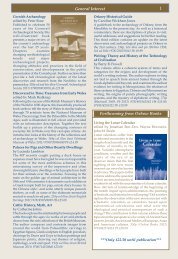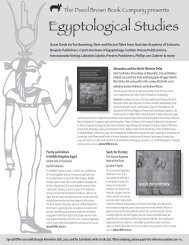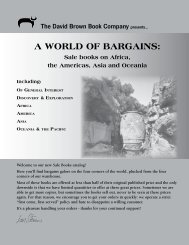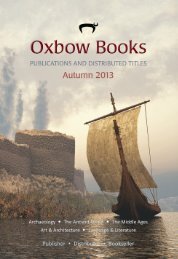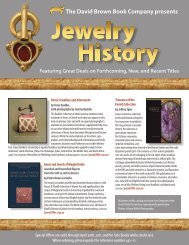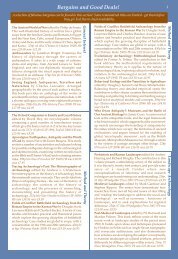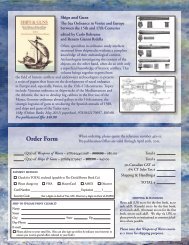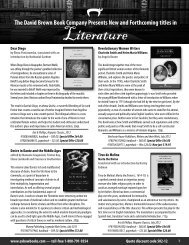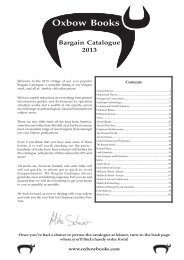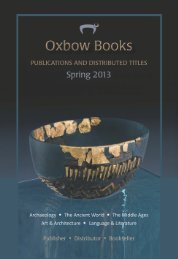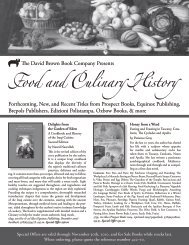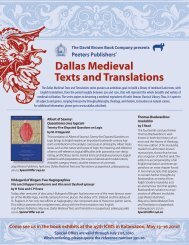New Distributed Titles Fall 2009 - Oxbow Books
New Distributed Titles Fall 2009 - Oxbow Books
New Distributed Titles Fall 2009 - Oxbow Books
You also want an ePaper? Increase the reach of your titles
YUMPU automatically turns print PDFs into web optimized ePapers that Google loves.
Norton Priory<br />
Monastery to Museum – Excavations 1970–87<br />
edited by Fraser Brown and Christine Howard-Davis<br />
The Priory of St Mary was moved from Runcorn to Norton in 1134 by William FitzWilliam,<br />
third baron of Halton. Norton grew in size and stature to become an abbey in 1391.<br />
The abbey met its end in April 1536 under Henry VIII’s dissolution of religious houses,<br />
and in 1545 the site was sold to the Brooke family, who adapted parts of the abbot’s<br />
quarters, kitchens and west range to provide a comfortable family home. In the mideighteenth<br />
century, much of the house was demolished. Ground-breaking excavations<br />
began in 1970, running until 1987, and exposing much of the site for investigation.<br />
This book provides a full account of the results of the excavations.<br />
474p, b/w and col illus, hardback, 9780904220520, $97.00, Oxford Archaeology, December 2008, Lancaster Imprints 16.<br />
Farm Buildings of the Weald 1450–1750<br />
by David and Barbara Martin<br />
An ancient timber-framed house with its attendant farm buildings<br />
nestling amidst a patchwork of tiny hedge-lined fields<br />
makes an idyllic country scene. This volume is a study of these<br />
underrated buildings, and the culmination of 25 years of research.<br />
The aim is to give a clear overview of how the region’s barns and<br />
ancillary farm buildings were designed to meet the needs of local<br />
agriculture and to indicate how these needs changed during the<br />
300 years up to the mid-18th century.<br />
181p, illus, paperback, 9781905223244, $50.00,<br />
Heritage Publications, July <strong>2009</strong>.<br />
The Rose and the Globe – Playhouses of Tudor Bankside, Southwark<br />
Excavations 1988–91<br />
by Julian Bowsher and Pat Miller<br />
The excavation of two of the famous playhouses of Tudor London, the Rose and the Globe, provided<br />
the first concrete evidence for the size, layout and development of these playhouses. The hundreds of<br />
individual elements found in the excavations, together with newly researched documentary sources,<br />
have been fully integrated into a narrative description and thematic discussions on every aspect of the<br />
playhouses, the plays and the audiences.<br />
280p, 172 col & b/w illus, hardback, 9781901992854, $59.95, Museum of London Archaeological Service,<br />
December <strong>2009</strong>, MoLAS Monograph 48.<br />
Finsbury’s Moated Manor House, Medieval Land Use<br />
and Later Development in the Moorfields Area, Islington<br />
by Ken Pitt with Jez Taylor<br />
Archaeological investigations at seven sites within the Finsbury Square area have revealed important<br />
evidence for the medieval and post-medieval development of this area north of the city walls.<br />
74p, 45 b/w illus, 11 tbls, paperback, 9781901992816, $18.00, Museum of London Archaeological Service,<br />
May <strong>2009</strong>, MoLAS Archaeology Studies 20.<br />
british archaeology<br />
Hill Hall<br />
A Singular House Devised by a Tudor Intellectual<br />
by Paul Drury and Richard Simpson<br />
This is the complete history of a building that began as a hunting<br />
lodge and grew to be the principal house of the manor of<br />
Theydon Mount in Essex. In 1556, the house was acquired by<br />
Sir Thomas Smith (1512–77). He rebuilt the house in Frenchinfluenced<br />
classical style and decorated it with wall paintings,<br />
conveying complex messages of morality and affinity as part<br />
of a coherent program of images in paint, glass and tiles.<br />
Archaeological excavation and detailed recording of the surviving<br />
fabric took place prior to the restoration of the house and<br />
its mural paintings, the results of which are now presented in<br />
this copiously illustrated account of one of the most important<br />
and influential houses to be built in Elizabethan England.<br />
544p, 378 illus, hardback, 9780854312917, $110.00,<br />
Society of Antiquaries, May <strong>2009</strong>.<br />
The Royal Ordnance Factory at Hayes<br />
The Story of a World War II Gun and Tank Factory<br />
at Hayes in the London Borough of Hillingdon<br />
by Nick Holder<br />
This is the fascinating story of a World War II tank and gun<br />
factory in West London. Using wartime documents, specially<br />
commissioned architectural photographs and - most importantly<br />
- the recollections of some of the factory’s workers, the<br />
book aims to tell the little-known story of how ROF Hayes<br />
played its part in the war effort.<br />
48p, col illus, paperback, 9781901992885, $15.95,<br />
Museum of London Archaeological Service, October <strong>2009</strong>.<br />
www.dbbconline.com 37




